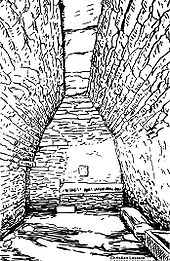Village des Bories
[2] The word “Borie” originates from an 18th-century place name – “Les Borrys”, in the Bouches-du-Rhône département – that was mistakenly construed as meaning “dry stone hut” by a mid 19th-century scholar.
The emergence of the outlying hamlet of “Les Savournins” dates back to a wide scale campaign of land clearing and cultivation that took place in 18th-century Provence, following a 1766 royal edict.
[4] The potsherds found in the huts and fields during the restoration work of the 1970s are characteristic of the earthenware manufactured in the Apt, Vaucluse, region in the 18th-19th centuries.
[6] Out of the 28 stone buildings still extant on the site, The prevalence of the “Gordoise nave”, together with the use of mortarless masonry, lends the hamlet a certain architectural unity.
The “Village des Bories” comprises several “groups” of “cabanes” which are distributed across the areas North and South of a lane that runs through the site.




